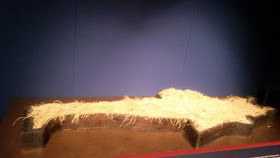Carnarvon: "Can you see anything?"On Tuesday, I visited the travelling exhibition about the Egyptian pharaoh Tutankhamun in Stockholm. It was all made up of replicas and as someone working in the heritage sector, I think it is a great idea. Not everyone has the money to travel to Egypt, but is still in love with its history and the amazing artefacts I think we can safely say that everyone has seen at least once in a book or on TV.
Carter: "Yes, wonderful things!"
I really enjoyed the exhibition. They really had tried to put all the artefacts into a context, which was a pleasant surprise. I thought it was going to be, like it often is with travelling exhibitions like this. Especially when it comes to really famous objects. But it is important for the understanding of the objects to have a context to place them in.
The objects are of course amazing in themselves, but there is much to be learned from them as well. Ancient Egypt is really a very different culture (even from today's Egypt) and to create an understanding of it, we much put all those treasures into a context to really understand it.
Even though I have had an interest in Ancient Egypt for years (I have also studied Egyptology at the university for a year.), I still think I have lots to learn. This also became pretty obvious at the exhibition. For the first time, I really understood what a so called corn Osiris looked like. (See picture bellow.)
 |
| Corn Osiris |
I missed a mummy, even though I totally understand why it was not possible to have one. The had a wall explaining research that has been done on the mummy and different theories of how he might have died. Underneath had they placed a table with a picture of the mummy. This was actually quite a good way to sudstitute, even though I do prefer real mummies. (Yes, I am somewhat obsessed with death and burials!)
While you walked around among the artefacts after this view of the tomb itself you could choose if you wanted to listen to more or just walk around and I was really amazed by it all. It had me thinking a lot. For example how the outer chapel of the coffins were built. The replica was placed on a podium the size of the burial chamber and the builders can not have had much space to move around as they built it for sure. And how do you actually move coffins of solid gold that weigh over 1 000 kilos?! Because I refuse to say aliens, I am going for a lot of block and tackles and hard working workers (No, Ancient Egypt did not keep slaves! In fact the first known strike in history is of Egyptian tomb workers who fought for higher salary.).
To sum it all up: I loved the exhibition. More should be made like this.



Inga kommentarer:
Skicka en kommentar